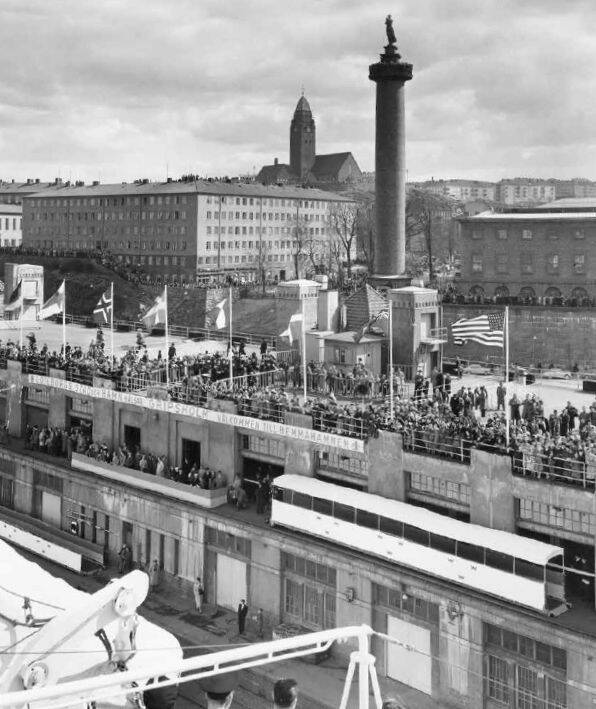During the 20th century, plans emerged to make Gothenburg a major port. Construction of Sannegårdshamnen began, and Gothenburg evolved into Scandinavia's most important export port. Shipping companies expanded significantly, and shipyards dominated the industrial landscape.

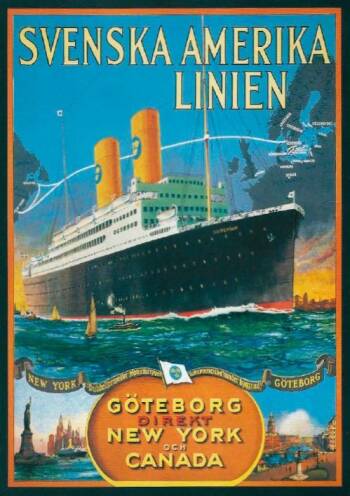
20th century


GRETA GARBO EMIGRATES
Greta Garbo departed from Gothenburg when she emigrated in 1925. She has a staircase named in her honor at the America Terminal, where the headquarters of the Port of Gothenburg is located today.
THE AMERICA LINE
In the early 20th century, the Swedish America Line launched direct service between Gothenburg and New York.
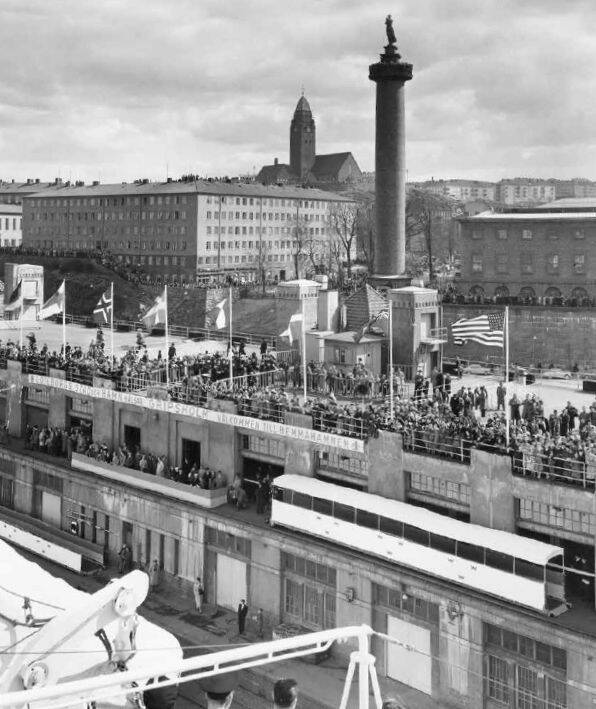
THE AMERICA LINE
The breakthrough for direct service between Gothenburg and North America came with the Swedish America Line. The initiative was taken by Wilhelm R. Lundgren, whose shipping company, Transatlantic, had successfully operated routes to South Africa and Australia. However, Lundgren passed away before the America Line became a reality. His idea was carried forward by Gunnar Carlsson and shipowner Dan Broström, who became the first CEO of the America Line.
The first ship to New York, the SS Stockholm, departed in 1915. By this time, Swedish emigration had slowed considerably—although a final major wave occurred in 1923. Most passengers were Swedes visiting relatives in the United States. As that traffic declined, the America Line became one of the world’s leading cruise lines, attracting a highly exclusive clientele. Ships departed from Stigbergskajen, and for this purpose, the "America Terminal" (Amerikaskjulet) was built, which now houses the headquarters of the Port of Gothenburg (Göteborgs Hamn AB).
The emigration wave was at its peak in the 1880s, bringing larger ships and increased frequency. In 1904, for example, Calypso, the largest passenger steamer on the North Sea at that time, was introduced on the route between Gothenburg and Hull, England.
Direct line to New York
Today, fish and seafood arrive by truck instead of boat at Gothenburg’s Fish Harbor.
With the new century came plans to transform Gothenburg into a major port, requiring expansion on the Hisingen side as well. Between 1908 and 1914, Sannegårdshamnen was constructed, though it was preceded by a significant landslide when clay masses slid into the river during excavation. With its arch-shaped basin, Sannegårdshamnen quickly became an essential part of the port.
For many years, it served as the central harbor for coal and coke imports, housing, for example, SJ’s entire stockpile for southern Sweden. Later, Sannegårdshamnen primarily became a container storage area but also functioned as a salt port. After World War II, oil harbors took over as fuel harbors, making Sannegårdshamnen the main harbor for conventional shipping to European destinations.
Today, the area is owned by the City of Gothenburg, and in the early 2000s, residential developments began, first on the east side of the basin, then on the west side, followed by the inner part of Sannegårdshamnen.
THE FISH HARBOR
In the latter half of the 19th century, fish handling took place at Rosenlund Canal, first on a large barge and later in Feskekôrka, built in 1874. By the early 20th century, it became clear that Gothenburg needed a larger fish harbor with fish and packing halls as well as facilities for processing and transport.
There was talk of locating the new harbor in Långedrag, but as it was outside the city’s jurisdiction, the choice fell instead on Södra Älvstranden. The Fish Harbor was built west of Stigbergskajen, became operational in 1910, and was the largest of its kind in the Nordic countries. The harbor gradually expanded, and by the late 1940s, the fish auction employed around 60 full-time staff. In 1970, the City of Gothenburg handed over the Fish Harbor to the Gothenburg Fish Auction Association, a coalition of fishermen's organizations, the canning industry, fish wholesalers, and fish retailers in Gothenburg. In the early 1990s, some buildings were demolished, and parts of the basin were filled in to create parking lots and new buildings, as fish were now transported to the market by truck rather than by boat.
The original auction hall, built in 1914, was demolished and replaced in 1993 by a new building. Today, most visitors are school groups and other pre-booked tours that receive guided visits around the fish halls. Gothenburg’s Fish Harbor is also a popular spot for bird watchers—especially in winter, when the area attracts rare gulls.
Expansion on Hisingen and a new fish harbor

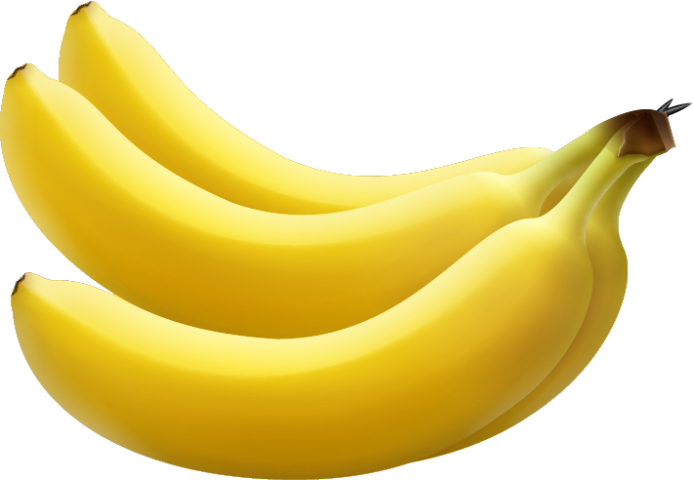
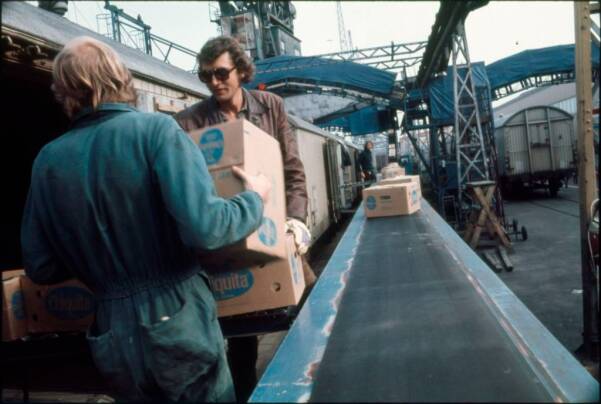
A century of bananas
Sweden is one of the world's top banana-consuming countries, with approximately 17 kilograms per person per year, and for over a hundred years, bananas were imported through the Port of Gothenburg. In March 1909, The Banana Company AB was established, soon renamed AB Banan-Kompaniet. The first shipment arrived black-frozen, with only a few bananas fit for sale. However, as fresh shipments arrived, interest in the exotic fruit grew, reaching an annual sales volume of 10,418 tons by 1930.
Over the years, banana handling at the Port of Gothenburg evolved dramatically. Initially, banana bunches were carried from the ship to the quay by hand. The first refrigerated ships for banana transport were introduced in 1945. After World War II, faster and safer ships allowed the bananas to be shipped directly from production countries in the West Indies to AB Banan-Kompaniet's terminal in Frihamnen, Gothenburg.
For a time, bananas were unloaded via conveyor belts emerging from the hull of the ships. By the early 2000s, bananas were transported in refrigerated containers on deck and on pallets in the ship's cold storage. Ships docked at Skandiahamnen, an outer port with container traffic, where the containers and pallets were unloaded by cranes.
In 2014, the last banana boat docked at the Port of Gothenburg. These bananas came from Panama and Costa Rica in Central America, a journey that took about twelve days. The banana boats were painted white to protect the cargo from the tropical sun, which could heat the ship, and were equipped with special refrigerated rooms kept at a constant 14 degrees Celsius to halt the ripening process.
The banana boat was a symbol of the port and international trade. Many Gothenburg residents have fond memories of the banana boat from when it docked at the Banana Pier in Frihamnen and was more visible in the city. In the past, unloading bananas required a lot of manpower, and many locals took casual shifts, known as “lightning shifts,” on the banana boats.
The banana boat brought bananas directly from another continent to Sweden. The Port of Gothenburg remains the only Swedish port with direct container traffic routes to other continents.
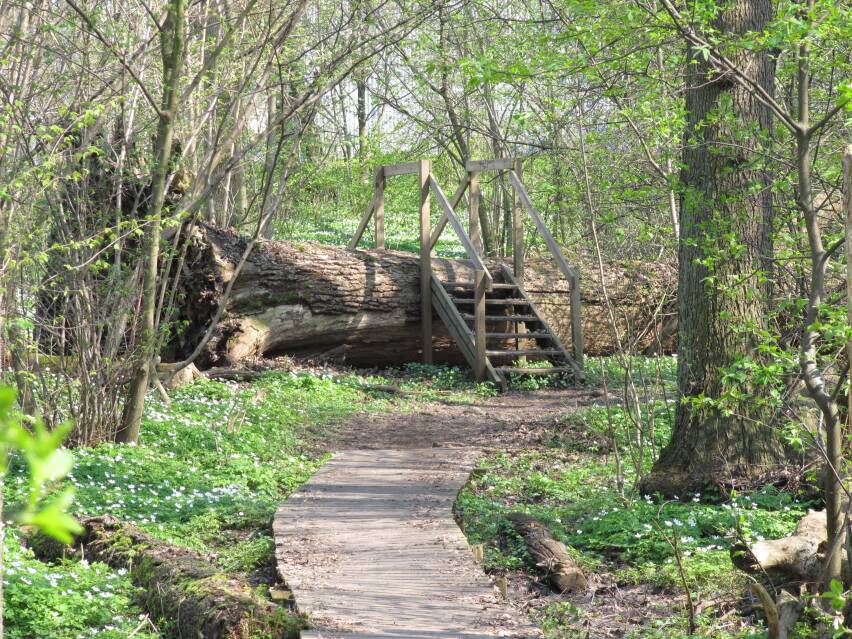
RYA FOREST
Hiking Trail in Rya Forest
THE FREE PORT
BMC Cooper cars were imported to Sweden through quay 114 in the Free Port (Frihamnen) in the late 1960s.
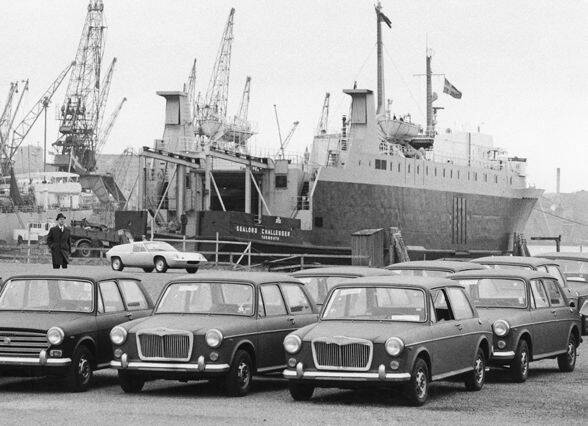
Frihamnen opens and the Oil harbor is born
RYA FOREST AND RYA HARBOR
Rya Forest is an ancient woodland with a large oak population, situated between Gryaab and the Energy Harbor, just west of the northern base of the Älvsborg Bridge. Around 1900, the area along the river was a popular destination, especially for swimming. As Gothenburg expanded westward, there was a risk that the entire forest would be cleared. However, the Swedish Society for Nature Conservation fought to make it the county’s first nature reserve, a status it gained in 1928. When Gothenburg's wastewater treatment plant needed to expand in the early 1990s, authorities, after strong protests, required the expansion to occur within the existing area. New technology made it possible to build upwards instead.
In the early 1930s, Rya Harbor was constructed, laying the groundwork for today’s Energy Harbor. Here, major oil companies quickly expanded their tank facilities.
A later project in Rya Harbor is the Rya Combined Heat and Power Plant, which began operations in autumn 2006. Operated by Göteborg Energi, the facility utilizes the heat generated during electricity production. The plant is fueled by natural gas, maximizing the energy extracted from the fuel.
The Free Port (Frihamnen) earned its name because goods could historically be landed "freely" there, meaning no customs duties or VAT were paid until the importer moved the goods out through the Free Port gate.
The need for a free port arose with the emergence of modern infrastructure. The breakthrough of steamships created entirely new conditions for regular shipping lines, necessitating greater port capacity and improved structure. Additionally, both railways and canals had been expanded.
The first proposal for a free port was made as early as the late 1800s, sparking a lively debate for many years. Both size and location were discussed. Eventually, the City Council decided to expand the central harbor, and in 1922, the Free Port was inaugurated.
Located on the Hisingen side, just west of where the Göta Älv Bridge would later anchor its northern end, it consists of three piers: South Free Port Pier (Bananpiren), North Free Port Pier, and Kville Pier. The oldest parts of the Free Port date back to the 1920s, though many sheds and warehouses are much newer. For a long time, bananas were unloaded here.
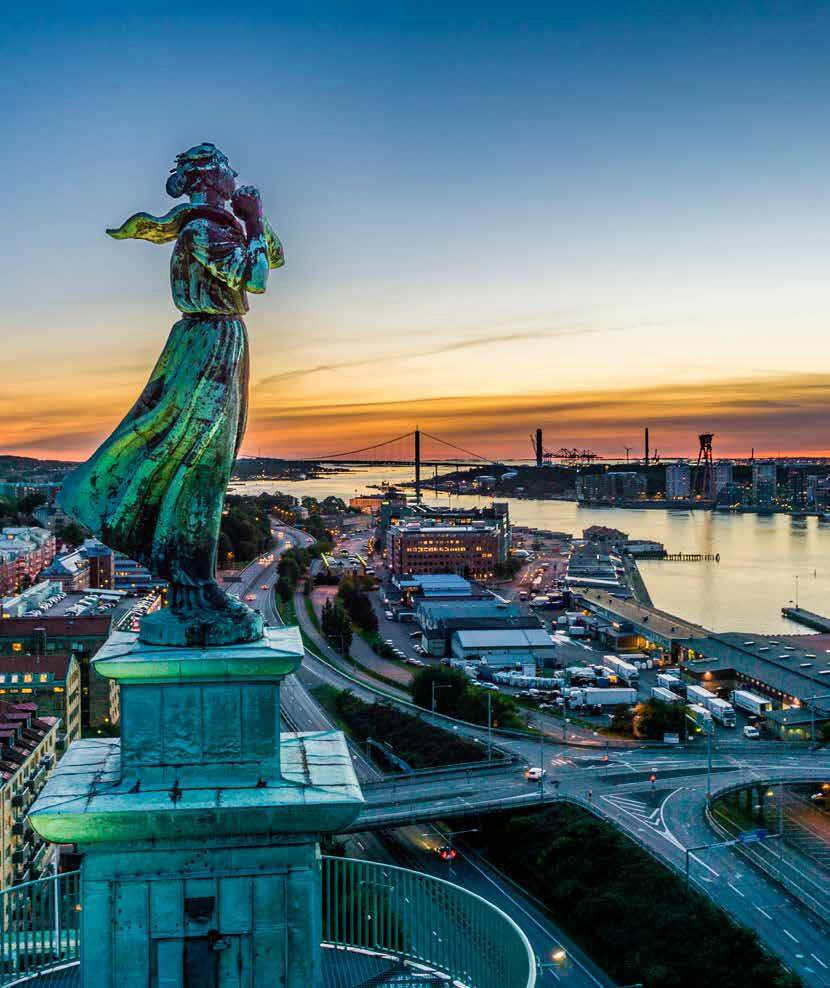
Lindholmen develops and the Maritime Museum is inaugurated
Lindholmen is located between Sannegårdshamnen and the Free Port (Frihamnen) and was the first part of Hisingen to be industrialized. In the mid-1850s, a shipyard for iron ships was built here, soon expanded with a mechanical workshop for steamships. The shipyard was taken over by Motala Verkstad and grew to become one of Sweden’s largest. However, the parent company encountered financial difficulties and went bankrupt in 1891. At that time, the shipyard was Gothenburg’s largest employer.
The business continued under new ownership and was restructured several times over the following decades. The shipyard maintained its focus on steam technology for a long time, but in 1936 it invested in diesel-electric machinery, coinciding with its reformation into Aktiebolaget Lindholmens Varv. The shipyard then also began specializing in dry cargo ships of unique design and steam boilers. During the war years of 1939–1945, 23 ships were launched from Lindholmen, and by 1960, the shipyard employed 1,800 people, including 1,400 workers.
However, in the late 1960s, the shipyard faced financial difficulties due to a new type of ferry for England. In 1971, the company was sold to Eriksbergs Mekaniska Verkstad, which transferred many skilled workers to Eriksberg.
In 1974, the last ship was built at Lindholmen. Only repair operations remained, which Eriksberg sold to Götaverken, but that, too, ceased in 1985.
In recent years, Lindholmen has transformed into a hub of knowledge and a vibrant educational center focused on innovation and research. It is home to Lindholmen Science Park, the Gothenburg Film Studios cluster, and rapidly expanding automotive developers.
THE MARITIME MUSEUM AND SEAMEN'S TOWER
Next to Stigbergstorget, on the hill above the America Terminal, stands the Maritime Museum Aquarium. Opened in 1933, it was funded by a donation from the Broström family company, Ångfartygs-AB Tirfing. After World War I, it was decided to erect a monument at the museum in memory of seamen lost at sea during the war. Named the Seamen's Tower, it stands 62 meters above sea level. Visitors can take an elevator to the top and enjoy magnificent views over the harbor and Majorna. At the top of the monument stands a five-meter-tall statue of a woman, "The Sailor’s Wife," gazing out to sea.
View of Stenpiren and Packhusplatsen in the Early 1940s
In the background is the Free Port (Frihamnen), which served as the site for two prisoner exchanges during World War II.

The Port is blockaded during the war
The war years brought both increased and decreased activity to the port city of Gothenburg. Industries and shipyards operated at full capacity, while trade declined.
The Port of Gothenburg held strategic importance, and in spring 1944, plans were made to prevent its use for German purposes. These plans included the destruction of the Göta Älv Bridge and the blockade of the harbor entrance. Three ships were part of "Operation Blockade," and on the morning of May 1, two large tankers were scuttled across the river, with a smaller cargo ship prepared for detonation.
During the war, the Free Port (Frihamnen) was the setting for two prisoner exchanges, one on the S/S Drottningholm and another on the M/S Gripsholm. From 1942 until the end of the war, these ships were chartered by the U.S. government and the Red Cross to serve as exchange vessels for prisoners of war, diplomats, and other civilian detainees. They had safe passage and traveled fully illuminated across the seas.

More oil, cars, and the first containers
NEW OIL HARBORS
As crude oil imports increased, Rya Harbor could no longer handle the volume. In the early 1950s, construction began on a new oil harbor, Skarvikshamnen, completed in 1957 with two quay berths. Another berth was added in 1965.
Two years later, Torshamnen was built, extending Gothenburg’s port operations further west. Located at Hjärtholmen in the Rivö Fjord before the harbor entrance, it initially accommodated vessels up to 90,000 tons. After the channel was deepened in 1968–1969, the pier could receive ships up to 225,000 tons.
SKANDIA HARBOR
Sweden’s economy surged in the decades following World War II. Both exports and imports grew, and with shipping, vessels became larger, and containers emerged as a crucial form of cargo. This required new and larger quays in Gothenburg, and in 1966, the Skandia Terminal opened on the Hisingen side, opposite Käringberget. It was a large container terminal equipped with powerful cranes and asphalted areas for trucks. Built by enclosing and filling in 1,300,000 square meters of Älvsborg Fjord, Skandia Harbor had been planned for years and was adapted at the last moment for container traffic. Port expansion continued until 1973, making it a hub for the shipping route between Gothenburg and England. In the early 2000s, passenger traffic to and from England moved to the Free Port Pier, where it continued for a few years.
Today, container traffic dominates, and Skandia Harbor is the largest of its kind in the Nordic region, handling 60 percent of Sweden’s container market. Car import and export are also significant, with the largest car carriers able to transport over 8,000 vehicles. The car terminal is operated by logistics company Logent, while the container terminal is managed by APM Terminals, a leading global terminal operator that has made substantial investments to increase efficiency.
Container handling requires large cranes, and new ones arrived in 2015. At 127 meters tall in their top position, they are the tallest container cranes in Scandinavia. Skandia Harbor now has ten container cranes, including five Super Post Panamax cranes.
Today, over half of all containers to and from the Port of Gothenburg are transported by rail. The investment in rail shuttles and the Railport Scandinavia concept, which connects directly to and from 25 inland terminals in Sweden and Norway, has been a major success, saving time and reducing CO2 emissions. In 2011, a new rail yard was inaugurated to increase rail capacity.

20th century
During the 20th century, plans emerged to make Gothenburg a major port. Construction of Sannegårdshamnen began, and Gothenburg evolved into Scandinavia's most important export port. Shipping companies expanded significantly, and shipyards dominated the industrial landscape.
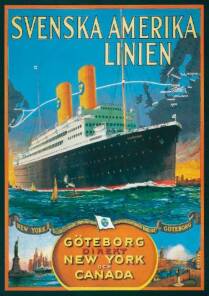

THE AMERICA LINE
The breakthrough for direct service between Gothenburg and North America came with the Swedish America Line. The initiative was taken by Wilhelm R. Lundgren, whose shipping company, Transatlantic, had successfully operated routes to South Africa and Australia. However, Lundgren passed away before the America Line became a reality. His idea was carried forward by Gunnar Carlsson and shipowner Dan Broström, who became the first CEO of the America Line.
The first ship to New York, the SS Stockholm, departed in 1915. By this time, Swedish emigration had slowed considerably—although a final major wave occurred in 1923. Most passengers were Swedes visiting relatives in the United States. As that traffic declined, the America Line became one of the world’s leading cruise lines, attracting a highly exclusive clientele. Ships departed from Stigbergskajen, and for this purpose, the "America Terminal" (Amerikaskjulet) was built, which now houses the headquarters of the Port of Gothenburg (Göteborgs Hamn AB).
The emigration wave was at its peak in the 1880s, bringing larger ships and increased frequency. In 1904, for example, Calypso, the largest passenger steamer on the North Sea at that time, was introduced on the route between Gothenburg and Hull, England.
Direct line to New York
With the new century came plans to transform Gothenburg into a major port, requiring expansion on the Hisingen side as well. Between 1908 and 1914, Sannegårdshamnen was constructed, though it was preceded by a significant landslide when clay masses slid into the river during excavation. With its arch-shaped basin, Sannegårdshamnen quickly became an essential part of the port.
For many years, it served as the central harbor for coal and coke imports, housing, for example, SJ’s entire stockpile for southern Sweden. Later, Sannegårdshamnen primarily became a container storage area but also functioned as a salt port. After World War II, oil harbors took over as fuel harbors, making Sannegårdshamnen the main harbor for conventional shipping to European destinations.
Today, the area is owned by the City of Gothenburg, and in the early 2000s, residential developments began, first on the east side of the basin, then on the west side, followed by the inner part of Sannegårdshamnen.
THE FISH HARBOR
In the latter half of the 19th century, fish handling took place at Rosenlund Canal, first on a large barge and later in Feskekôrka, built in 1874. By the early 20th century, it became clear that Gothenburg needed a larger fish harbor with fish and packing halls as well as facilities for processing and transport.
There was talk of locating the new harbor in Långedrag, but as it was outside the city’s jurisdiction, the choice fell instead on Södra Älvstranden. The Fish Harbor was built west of Stigbergskajen, became operational in 1910, and was the largest of its kind in the Nordic countries. The harbor gradually expanded, and by the late 1940s, the fish auction employed around 60 full-time staff. In 1970, the City of Gothenburg handed over the Fish Harbor to the Gothenburg Fish Auction Association, a coalition of fishermen's organizations, the canning industry, fish wholesalers, and fish retailers in Gothenburg. In the early 1990s, some buildings were demolished, and parts of the basin were filled in to create parking lots and new buildings, as fish were now transported to the market by truck rather than by boat.
The original auction hall, built in 1914, was demolished and replaced in 1993 by a new building. Today, most visitors are school groups and other pre-booked tours that receive guided visits around the fish halls. Gothenburg’s Fish Harbor is also a popular spot for bird watchers—especially in winter, when the area attracts rare gulls.
Today, fish and seafood arrive by truck instead of boat at Gothenburg’s Fish Harbor.
Expansion on Hisingen and a new fish harbor
A century of bananas
Sweden is one of the world's top banana-consuming countries, with approximately 17 kilograms per person per year, and for over a hundred years, bananas were imported through the Port of Gothenburg. In March 1909, The Banana Company AB was established, soon renamed AB Banan-Kompaniet. The first shipment arrived black-frozen, with only a few bananas fit for sale. However, as fresh shipments arrived, interest in the exotic fruit grew, reaching an annual sales volume of 10,418 tons by 1930.
Over the years, banana handling at the Port of Gothenburg evolved dramatically. Initially, banana bunches were carried from the ship to the quay by hand. The first refrigerated ships for banana transport were introduced in 1945. After World War II, faster and safer ships allowed the bananas to be shipped directly from production countries in the West Indies to AB Banan-Kompaniet's terminal in Frihamnen, Gothenburg.
For a time, bananas were unloaded via conveyor belts emerging from the hull of the ships. By the early 2000s, bananas were transported in refrigerated containers on deck and on pallets in the ship's cold storage. Ships docked at Skandiahamnen, an outer port with container traffic, where the containers and pallets were unloaded by cranes.
In 2014, the last banana boat docked at the Port of Gothenburg. These bananas came from Panama and Costa Rica in Central America, a journey that took about twelve days. The banana boats were painted white to protect the cargo from the tropical sun, which could heat the ship, and were equipped with special refrigerated rooms kept at a constant 14 degrees Celsius to halt the ripening process.
The banana boat was a symbol of the port and international trade. Many Gothenburg residents have fond memories of the banana boat from when it docked at the Banana Pier in Frihamnen and was more visible in the city. In the past, unloading bananas required a lot of manpower, and many locals took casual shifts, known as “lightning shifts,” on the banana boats.
The banana boat brought bananas directly from another continent to Sweden. The Port of Gothenburg remains the only Swedish port with direct container traffic routes to other continents.

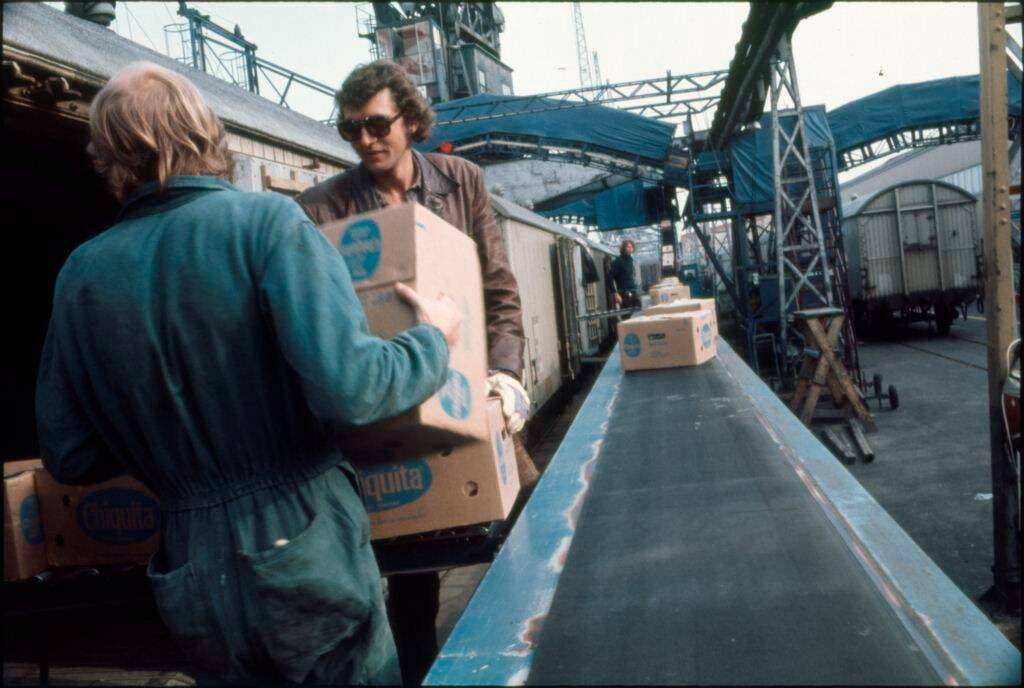
Frihamnen opens and the Oil harbor is born
THE FREE PORT
BMC Cooper cars were imported to Sweden through quay 114 in the Free Port (Frihamnen) in the late 1960s.
RYA FOREST
Hiking Trail in Rya Forest
RYA FOREST AND RYA HARBOR
Rya Forest is an ancient woodland with a large oak population, situated between Gryaab and the Energy Harbor, just west of the northern base of the Älvsborg Bridge. Around 1900, the area along the river was a popular destination, especially for swimming. As Gothenburg expanded westward, there was a risk that the entire forest would be cleared. However, the Swedish Society for Nature Conservation fought to make it the county’s first nature reserve, a status it gained in 1928. When Gothenburg's wastewater treatment plant needed to expand in the early 1990s, authorities, after strong protests, required the expansion to occur within the existing area. New technology made it possible to build upwards instead.
In the early 1930s, Rya Harbor was constructed, laying the groundwork for today’s Energy Harbor. Here, major oil companies quickly expanded their tank facilities.
A later project in Rya Harbor is the Rya Combined Heat and Power Plant, which began operations in autumn 2006. Operated by Göteborg Energi, the facility utilizes the heat generated during electricity production. The plant is fueled by natural gas, maximizing the energy extracted from the fuel.
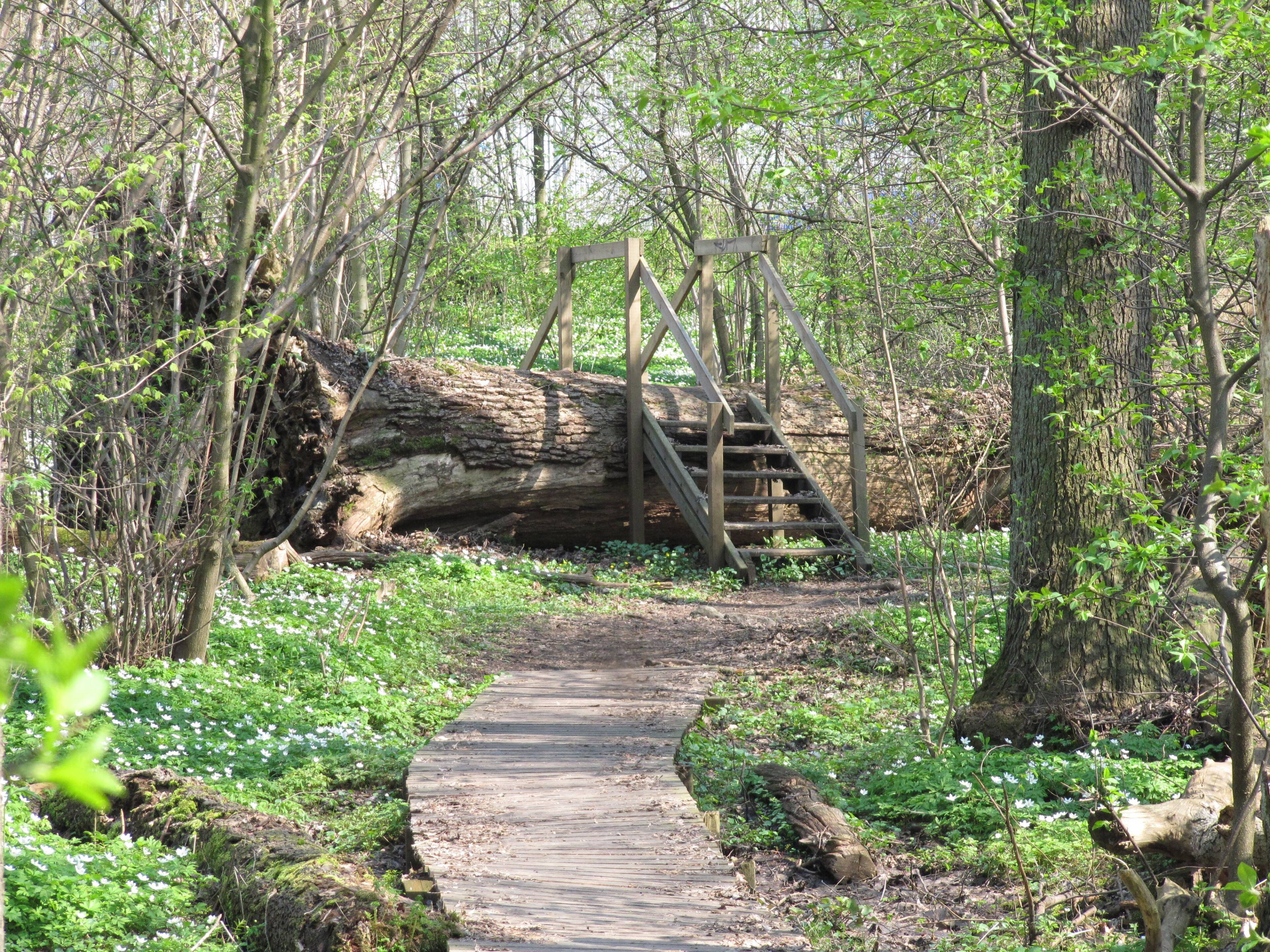
The Free Port (Frihamnen) earned its name because goods could historically be landed "freely" there, meaning no customs duties or VAT were paid until the importer moved the goods out through the Free Port gate.
The need for a free port arose with the emergence of modern infrastructure. The breakthrough of steamships created entirely new conditions for regular shipping lines, necessitating greater port capacity and improved structure. Additionally, both railways and canals had been expanded.
The first proposal for a free port was made as early as the late 1800s, sparking a lively debate for many years. Both size and location were discussed. Eventually, the City Council decided to expand the central harbor, and in 1922, the Free Port was inaugurated.
Located on the Hisingen side, just west of where the Göta Älv Bridge would later anchor its northern end, it consists of three piers: South Free Port Pier (Bananpiren), North Free Port Pier, and Kville Pier. The oldest parts of the Free Port date back to the 1920s, though many sheds and warehouses are much newer. For a long time, bananas were unloaded here.
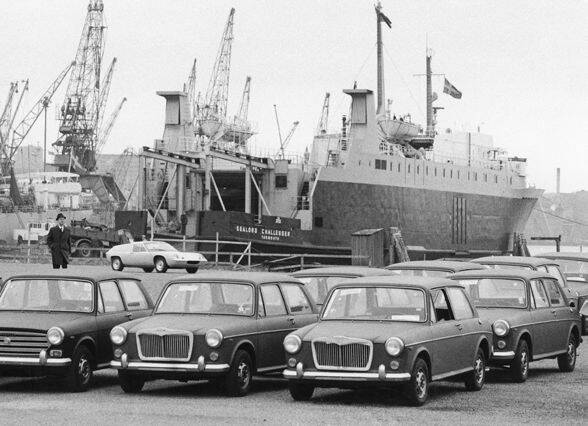
Lindholmen is located between Sannegårdshamnen and the Free Port (Frihamnen) and was the first part of Hisingen to be industrialized. In the mid-1850s, a shipyard for iron ships was built here, soon expanded with a mechanical workshop for steamships. The shipyard was taken over by Motala Verkstad and grew to become one of Sweden’s largest. However, the parent company encountered financial difficulties and went bankrupt in 1891. At that time, the shipyard was Gothenburg’s largest employer.
The business continued under new ownership and was restructured several times over the following decades. The shipyard maintained its focus on steam technology for a long time, but in 1936 it invested in diesel-electric machinery, coinciding with its reformation into Aktiebolaget Lindholmens Varv. The shipyard then also began specializing in dry cargo ships of unique design and steam boilers. During the war years of 1939–1945, 23 ships were launched from Lindholmen, and by 1960, the shipyard employed 1,800 people, including 1,400 workers.
However, in the late 1960s, the shipyard faced financial difficulties due to a new type of ferry for England. In 1971, the company was sold to Eriksbergs Mekaniska Verkstad, which transferred many skilled workers to Eriksberg.
In 1974, the last ship was built at Lindholmen. Only repair operations remained, which Eriksberg sold to Götaverken, but that, too, ceased in 1985.
In recent years, Lindholmen has transformed into a hub of knowledge and a vibrant educational center focused on innovation and research. It is home to Lindholmen Science Park, the Gothenburg Film Studios cluster, and rapidly expanding automotive developers.
THE MARITIME MUSEUM AND SEAMEN'S TOWER
Next to Stigbergstorget, on the hill above the America Terminal, stands the Maritime Museum Aquarium. Opened in 1933, it was funded by a donation from the Broström family company, Ångfartygs-AB Tirfing. After World War I, it was decided to erect a monument at the museum in memory of seamen lost at sea during the war. Named the Seamen's Tower, it stands 62 meters above sea level. Visitors can take an elevator to the top and enjoy magnificent views over the harbor and Majorna. At the top of the monument stands a five-meter-tall statue of a woman, "The Sailor’s Wife," gazing out to sea.
Lindholmen develops and the Maritime Museum is inaugurated
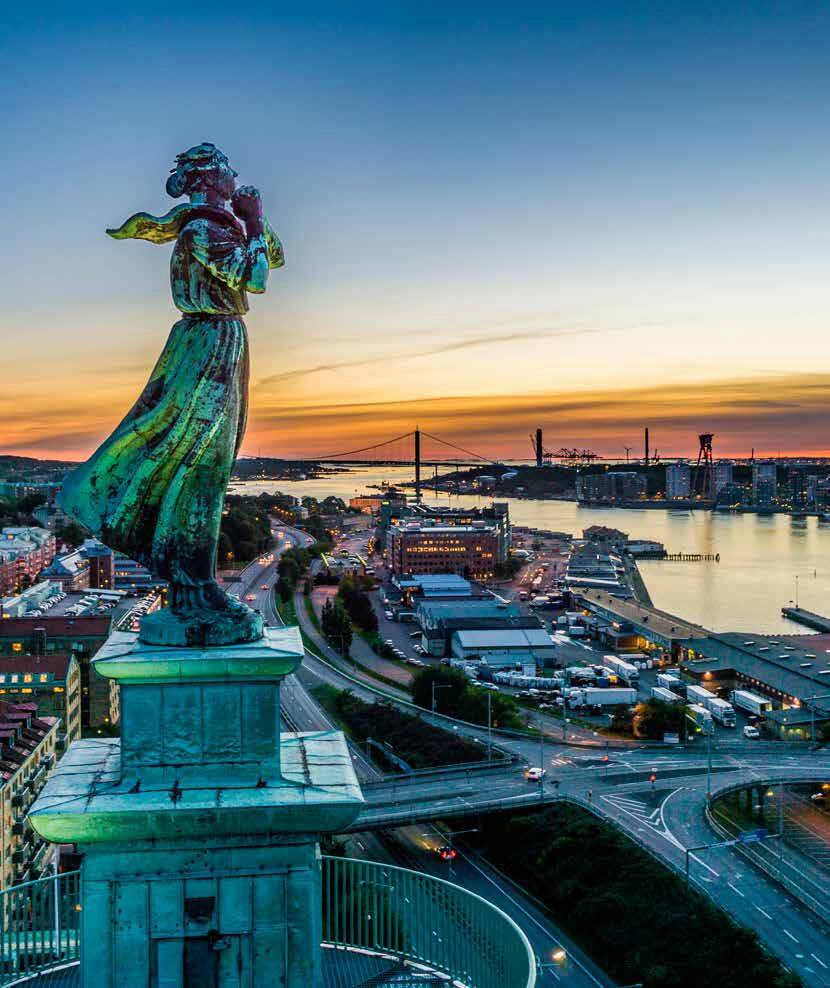
The war years brought both increased and decreased activity to the port city of Gothenburg. Industries and shipyards operated at full capacity, while trade declined.
The Port of Gothenburg held strategic importance, and in spring 1944, plans were made to prevent its use for German purposes. These plans included the destruction of the Göta Älv Bridge and the blockade of the harbor entrance. Three ships were part of "Operation Blockade," and on the morning of May 1, two large tankers were scuttled across the river, with a smaller cargo ship prepared for detonation.
During the war, the Free Port (Frihamnen) was the setting for two prisoner exchanges, one on the S/S Drottningholm and another on the M/S Gripsholm. From 1942 until the end of the war, these ships were chartered by the U.S. government and the Red Cross to serve as exchange vessels for prisoners of war, diplomats, and other civilian detainees. They had safe passage and traveled fully illuminated across the seas.
The Port is blockaded during the war
View of Stenpiren and Packhusplatsen in the Early 1940s
In the background is the Free Port (Frihamnen), which served as the site for two prisoner exchanges during World War II.
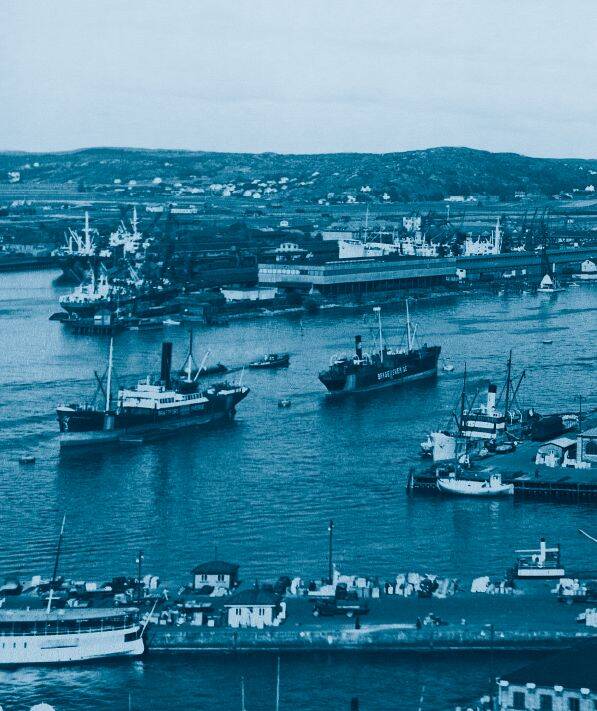
More oil, cars, and the first containers
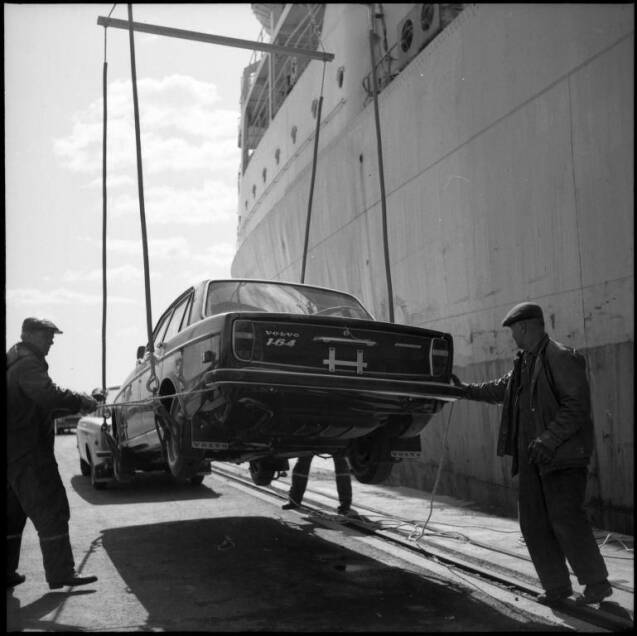
NEW OIL HARBORS
As crude oil imports increased, Rya Harbor could no longer handle the volume. In the early 1950s, construction began on a new oil harbor, Skarvikshamnen, completed in 1957 with two quay berths. Another berth was added in 1965.
Two years later, Torshamnen was built, extending Gothenburg’s port operations further west. Located at Hjärtholmen in the Rivö Fjord before the harbor entrance, it initially accommodated vessels up to 90,000 tons. After the channel was deepened in 1968–1969, the pier could receive ships up to 225,000 tons.
SKANDIA HARBOR
Sweden’s economy surged in the decades following World War II. Both exports and imports grew, and with shipping, vessels became larger, and containers emerged as a crucial form of cargo. This required new and larger quays in Gothenburg, and in 1966, the Skandia Terminal opened on the Hisingen side, opposite Käringberget. It was a large container terminal equipped with powerful cranes and asphalted areas for trucks. Built by enclosing and filling in 1,300,000 square meters of Älvsborg Fjord, Skandia Harbor had been planned for years and was adapted at the last moment for container traffic. Port expansion continued until 1973, making it a hub for the shipping route between Gothenburg and England. In the early 2000s, passenger traffic to and from England moved to the Free Port Pier, where it continued for a few years.
Today, container traffic dominates, and Skandia Harbor is the largest of its kind in the Nordic region, handling 60 percent of Sweden’s container market. Car import and export are also significant, with the largest car carriers able to transport over 8,000 vehicles. The car terminal is operated by logistics company Logent, while the container terminal is managed by APM Terminals, a leading global terminal operator that has made substantial investments to increase efficiency.
Container handling requires large cranes, and new ones arrived in 2015. At 127 meters tall in their top position, they are the tallest container cranes in Scandinavia. Skandia Harbor now has ten container cranes, including five Super Post Panamax cranes.
Today, over half of all containers to and from the Port of Gothenburg are transported by rail. The investment in rail shuttles and the Railport Scandinavia concept, which connects directly to and from 25 inland terminals in Sweden and Norway, has been a major success, saving time and reducing CO2 emissions. In 2011, a new rail yard was inaugurated to increase rail capacity.
